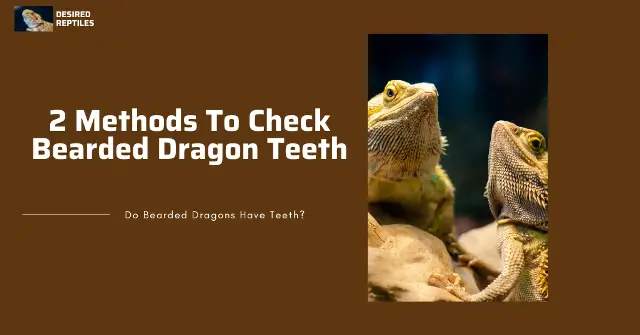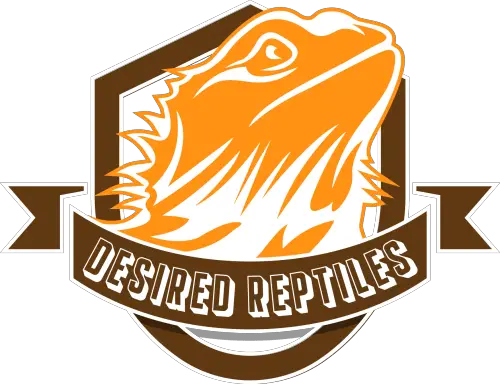You may wonder how bearded dragons manage to chomp on tough-skinned bugs, fight off rivals, or even defend themselves from people who threaten their peace of mind. The answer is more interesting than you might think, and I have emerged from the rabbit hole with all the facts you’ll need to quench your curiosity!
Bearded dragons do have rather sharp teeth, but unlike most mammals with familiar teeth, beardies have acrodont sets which are teeth-like protrusions directly from the jaw bones found in a wide range of reptiles including our dear beardies. In total, your bearded dragon has 26 to 38 teeth on their lower jaw, and 20 to 28 on their upper jaw.
In this article, I’ll explore everything about bearded dragon teeth, the possible dental diseases, and how to prevent them from troubling your pet. Let’s get right into it!

How To See Your Beardie’s Acrodont Teeth
If your bearded dragon opens its mouth pretty wide and you look carefully inside, you still might not see its teeth! This is because their teeth are ridiculously tiny, small enough to go under the radar of your view. However, if you’re pretty curious and your bearded dragon doesn’t mind the bother, here are two ways to see them:
Gently Press On The Sides Of Its Mouth
With your hands over your beardie’s head, place your thumb and index finger on either side of the edge of its mouth. In a gentle, really careful manner, apply pressure to these points and your dragon will instinctively open wide. As you do this, push the skin lining the mouth exactly above the mandibles away and you’ll find tiny rows of zig-zag-looking teeth.
Lift The Eyelids
Dragons dislike having their view obstructed and will open their mouths wide in response. With clean hands, place your index finger and thumb right above their eyelids and gently pull upward slightly. This will cause the dragon to open its mouth long enough for you to take a peek at its teeth.
Bearded Dragon Dental Diseases: Lethal Teeth Problems
At first, I found it hilarious that beardies require dental care. I imagined them lined up at the vet to get their teeth brushed and whitened with tiny dental tools! It may surprise you that poor dental hygiene can and will lead to life-threatening diseases. This is why I want to bring to your notice the three most common and horrifying dental diseases that can affect a bearded dragon:
Gingivitis – Gum Swelling And Bleeding
Gingivitis is the painful swelling and bleeding of a bearded dragon’s gums. It is directly linked to poor hygiene and the buildup of bacteria that weakens the protective barrier of the gums. When this happens, your beardie may stop eating or properly breaking down their food which would in turn lead to digestive problems such as constipation.
The worst part of gingivitis is that it slowly deteriorates your pet’s quality of life by causing immense stress and digestive problems which could lead to sudden death. You might think of it as a petty dental issue only to find your pet in a near-death condition hours later.
Osteomyelitis – Jawbone Disease
Osteomyelitis is a bone disease caused by either bacterial or fungal infections. In this case, it’s the worst form of gingivitis that attacks the jawbone of your bearded dragon causing it to become feeble and soft. Signs of early osteomyelitis include whitish spots around the gum and persistent swelling. Without treatment, it will disrupt the appetite of your pet and lead to worse cases like malnutrition and periodontal disease.
Periodontal Disease – Jawbone And Teeth Disease
While osteomyelitis is severe, periodontal disease is the worst representation of bearded dragon dental illness to exist. It involves the detachment of the row of teeth directly from the mandibles, which can become irreversible. Once it becomes irreversible, your pet will continuously lose its appetite, drastically reducing its well-being and affecting its immune system.
Dragons with periodontal disease usually don’t live as long as their healthy peers, especially when it has severely affected their feeding. It is usually associated with black splotches around the gum, swelling, and bleeding.
3 Major Causes Of Bearded Dragon Dental Disease
It’s understandable if you’re clutching your pearls at the aforementioned beardie dental diseases. The first step to preventing any of those from happening is to know how they even take place, so that you may apply precautions immediately!
There are three major causes of beardie dental diseases, and they are as follows:
1. Excessive Soft Food Choices
Aside from selecting the proper items for your pet’s nutritious diet, you must also consider the texture of the food you’re feeding your dragon. Too many soft foods like hornworms can lead to a buildup of plaque that is directly linked to gingivitis. Ensure your pet munches on crickets now and then to help them break the possible plaque formation after every soft meal.
2. Way Too Many Sweets
To bearded dragons, sweets come in the form of fruits and too much of this can deteriorate the lifespan of their teeth. While vitamin C is important to beardies, it should be kept at a minimum – at most twice a week – to prevent tooth or jaw decay from thriving.
3. Trauma To The Mouth Area
This problem usually occurs when two or more beardies are housed in the same terrarium. Beardies can get into nasty fights that could affect their teeth causing openings for bacteria to feast, play, and multiply.

Effective Ways To Care For Your Bearded Dragon’s Teeth
Fortunately, there are several measures you can take to ensure your dragon stays clear of painful dental complications that could be fatal in the worst-case scenario. Here are 4 good ways to do so:
Feed Your Dragon Crunchy Foods
The more the crunch, the less the plaque. Crunchy foods like butternut squash and dubia roaches are good choices for dental care that will assist in breaking plaque and preventing further infection.
Keep The Fruity Meals At A Minimum
As we have discussed, fruits contain an unsafe amount of sugar that can be troubling to your beardie’s teeth and gut health in large amounts. At most, fruits should be fed as a treat no more than twice a week. They must also be free of oxalic acid, persin, and extreme acidity. While feeding, ensure that the sizes/portions are small enough to fit into the space between your pet’s eyes to prevent choking or prolonged chewing of the sweet treats which could damage their teeth.
Clean And Inspect Your Beardie’s Teeth Regularly
Inspecting your bearded dragon’s teeth is highly important to help you keep track of its dental health. Cleaning their teeth with cotton buds is also a good way to break the accumulation of plaque along the line. I recommend inspecting their teeth every two weeks and cleaning them at least monthly as you go.
Note: If there is a hint of fungal infection or plaque, there is a different cleaning measure to follow usually done with chlorhexidine – an antifungal, antibacterial, and antiviral solution – only advisable to be used after a proper examination by your vet. This is because, depending on the stage of the infection, a particular dosage and instruction will be prescribed to tackle it– which brings us to our final point.
Visit The Vet For Regular Check-Ups
Veterinarians are most qualified to diagnose and treat your bearded dragon in case of a dental infection. In many ways, the disease could be worse than you think. It’s always the best decision to check in with your vet so that your beardie can have a better and stronger chance at fighting dental diseases.
10 Signs You Shouldn’t Ignore When Inspecting Your Dragon’s Teeth
During a routine dental inspection, here are signs your dragon may be suffering from painful dental diseases deserving of professional care and treatment:
- Bleeding around the gum area
- Black spots around the teeth and gum
- Swelling of gum
- Whitish spots around teeth and gum
- Redness of the gum
- Sagging mandibles
- Excessive secretion of saliva
- Loss of appetite
- Drowsiness or weakness
- Longer chewing and swallowing periods
The Conclusion
It may surprise you that dental problems are more common in captive bearded dragons than those in the wild. Well, wild beardies eat more of course-textured foods that will continuously get into the gum area and break plaque formation. On the other hand, captive beardies often eat softer foods over time which can lead to plaque buildup. With this breakdown, you should be able to prevent or identify dental infections and take the appropriate measures to treat the problem. Good luck!
